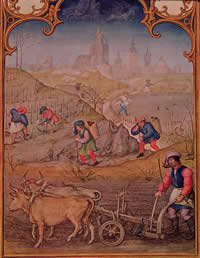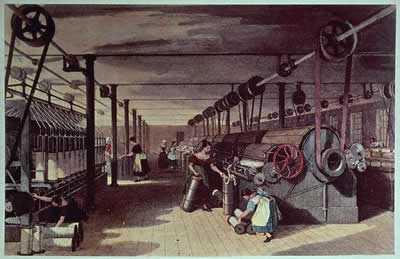Lesson Two: The Origins of Western Democratic Liberalism
4. Lesson 3.2.3 Classical Economic Liberalism
Classical liberalism takes an individualistic approach to an economic system.

Before 1750, life was not easy in the towns and farms of England. People had to work hard, and the primitive methods of farming were not very productive. Most work was done by hand with simple tools or with the help of animals. This method, a feudal system used for centuries, was slow and did not produce enough food for a growing population. In addition, only a limited amount of wealth could be produced under the old feudal system. Laws allowed very limited personal freedoms for most people.

Agricultural Scene
A Farm During the 17th Century
At the end of the 17th century (1600s), the economy of Europe was based on agriculture, as it had been for hundreds of years. Most Europeans lived on farms. Men and women laboured on the land, plowing fields and sowing crops, reaping harvests and storing grain.
Farming methods had not progressed much and farmers still relied upon a few simple home-made tools such as the wooden plow, the hoe, and the scythe. Animal and human muscle provided the power needed to farm the land.|
|
|---|
During the 1600s and 1700s, the economic system of mercantilism introduced the world to new trade markets. Mercantilism was an economic system based on the following:
-
The wealth of a country measured in gold and silver
-
Trade surpluses where a country needed to sell more than it bought by seeking out new trade markets overseas
-
Establishment of colonies to get resources and provide markets for selling goods
-
Government (absolute monarchies) regulation of business
-
Government-controlled monopolies in which only a few business were allowed to trade so profits were made mostly by government and a few businessmen
The new overseas markets introduced European entrepreneurs to new products, industry, machinery, and ways of life. In turn, international trade caused social and economic changes in Europe and helped initiate what became known as the Industrial Revolution.
Please watch the following video explain the Agricultural Revolution which helped lead to the Industrial Revolution:
The Industrial Revolution began with the textile industry in Great Britain around 1750 and reached its peak in 1850. The Industrial Revolution moved Great Britain from an agricultural society to an industrial society. Industrialization meant an increase in profits for those capitalists willing to risk their money in business. New businesses meant new products and a growth in new business.
Please watch the following video on the Industrial Revolution
Video:
Economic changes in Europe during the Industrial Revolution were based on individualism and gave rise to classical liberal ideology.

Factory Scene
A Textile Factory during the 19th Century
By the end of the 19th century (the 1800s) the economy of Europe was based on industrial production. Farmers were using factory-built machinery that could do the work of many men. Items that had been made by hand with simple tools were now made by machines in factories. Many Europeans had moved away from the countryside to work in factories located in cities. Animal and human muscle power was eventually replaced by steam engines.